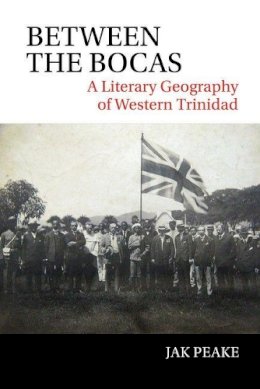
Stock image for illustration purposes only - book cover, edition or condition may vary.
Between the Bocas: A Literary Geography of Western Trinidad (American Tropics Towards a Literary Geography LUP)
Jak Peake
€ 171.02
FREE Delivery in Ireland
Description for Between the Bocas: A Literary Geography of Western Trinidad (American Tropics Towards a Literary Geography LUP)
Hardcover. Situated opposite the mouth of the Orinoco River, western Trinidad has long been considered an entrepot to mainland South America. This book offers a literary perspective on matters too often perceived as the sole preserve of sociological, anthropological or geographical studies. Series: American Tropics: Towards a Literary Geography. Num Pages: 256 pages. BIC Classification: 1KJWWT; 2AB; DSBH5. Category: (P) Professional & Vocational. Dimension: 239 x 163. .
Situated opposite the mouth of the Orinoco River, western Trinidad has long been considered an entrepôt to mainland South America. Trinidad’s geographic position—seen as strategic by various imperial governments—led to many heterogeneous peoples from across the region and globe settling or being relocated there. The calm waters around the Gulf of Paria on the western fringes of Trinidad induced settlers to construct a harbour, Port of Spain, around which the modern capital has been formed. From its colonial roots into the postcolonial era, western Trinidad therefore has played an especial part in the shaping of the island’s literature. Viewed from one perspective, western Trinidad might be deemed as narrating the heart of the modern state’s national literature. Alternatively, the political threats posed around San Fernando in Trinidad’s southwest in the 1930s and from within the capital in the 1970s present a different picture of western Trinidad—one in which the fractures of Trinidad and Tobago’s projected nationalism are prevalent.
While sugar remains a dominant narrative in Caribbean literary studies, this book offers a unique literary perspective on matters too often perceived as the sole preserve of sociological, anthropological or geographical studies. The legacy of the oil industry and the development of the suburban commuter belt of East-West Corridor, therefore, form considerable discursive nodes, alongside other key Trinidadian sites, such as Woodford Square, colonial houses and the urban yards of Port of Spain. This study places works by well-known authors such as V. S. Naipaul and Samuel Selvon, alongside writing by Michel Maxwell Philip, Marcella Fanny Wilkins, E. L. Joseph, Earl Lovelace, Ismith Khan, Monique Roffey, Arthur Calder-Marshall and the largely neglected novelist, Yseult Bridges, who is almost entirely forgotten today. Using fiction, calypso, history, memoir, legal accounts, poetry, essays and journalism, this study opens with an analysis of Trinidad’s nineteenth century literature and offers twentieth century and more contemporary readings of the island in successive chapters. Chapters are roughly arranged in chronological order around particular sites and topoi, while literature from a variety of authors of British, Caribbean, Irish and Jewish descent is represented.
While sugar remains a dominant narrative in Caribbean literary studies, this book offers a unique literary perspective on matters too often perceived as the sole preserve of sociological, anthropological or geographical studies. The legacy of the oil industry and the development of the suburban commuter belt of East-West Corridor, therefore, form considerable discursive nodes, alongside other key Trinidadian sites, such as Woodford Square, colonial houses and the urban yards of Port of Spain. This study places works by well-known authors such as V. S. Naipaul and Samuel Selvon, alongside writing by Michel Maxwell Philip, Marcella Fanny Wilkins, E. L. Joseph, Earl Lovelace, Ismith Khan, Monique Roffey, Arthur Calder-Marshall and the largely neglected novelist, Yseult Bridges, who is almost entirely forgotten today. Using fiction, calypso, history, memoir, legal accounts, poetry, essays and journalism, this study opens with an analysis of Trinidad’s nineteenth century literature and offers twentieth century and more contemporary readings of the island in successive chapters. Chapters are roughly arranged in chronological order around particular sites and topoi, while literature from a variety of authors of British, Caribbean, Irish and Jewish descent is represented.
Product Details
Publisher
Liverpool University Press
Format
Hardback
Publication date
2017
Series
American Tropics: Towards a Literary Geography
Condition
New
Weight
28g
Number of Pages
344
Place of Publication
Liverpool, United Kingdom
ISBN
9781781382882
SKU
V9781781382882
Shipping Time
Usually ships in 7 to 11 working days
Ref
99-50
About Jak Peake
Jak Peake is a Fulbright scholar and lecturer in American literature in the Department of Literature, Film, and Theatre Studies at the University of Essex. He was a member of the American Tropics research project based at Essex and funded by the UK Arts and Humanities Research Council.
Reviews for Between the Bocas: A Literary Geography of Western Trinidad (American Tropics Towards a Literary Geography LUP)
